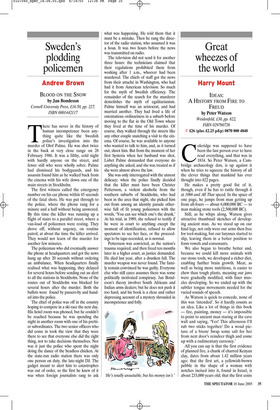Sweden’s plodding policemen
Andrew Brown
BLOOD ON THE SNOW by Jan Bondeson Cornell University Press, £16.50, pp. 227, ISBN 0801442117 There has never in the history of human incompetence been anything quite like the Swedish police’s investigation into the murder of Olof Palme. He was shot twice in the back at very close range on 28 February 1986. It was a filthy, cold night with hardly anyone on the street, and fewer still who were wholly sober. Palme had dismissed his bodyguards, and his assassin found him as he walked back from the cinema with his wife down one of the main streets in Stockholm.
The first witness called the emergency number on his car phone within 45 seconds of the fatal shots. He was put through to the police, where the phone rang for a minute and a half without being answered. By this time the killer was running up a flight of stairs to a parallel street, where a van-load of policemen were resting. They drove off, without urgency, on routine patrol, at about the time the killer arrived. They would not learn of the murder for another few minutes.
The policeman who did eventually answer the phone at headquarters and got the news hung up after 20 seconds without ordering an ambulance. When headquarters finally realised what was happening, they delayed for several hours before sending out an alert to all the stations in Stockholm. None of the routes out of Stockholm was blocked for several hours after the murder. Both the bullets were found by passers-by and handed into the police.
The chief of police was off in the country hoping to compete in a ski race the next day. His hotel room was phoned, but he couldn’t be reached because he was spending the night in another room with one of his prettier subordinates. The two senior officers who did come in took the view that they were there to see that everyone else did the right thing, not to take decisions themselves. Nor was it just the police who spent the night doing the dance of the headless chicken. At the state-run radio station there was only one person on duty, the late-night DJ. The gadget meant to alert him to catastrophes was out of order, so the first he knew of it was when foreign journalists rang to ask what was happening. He told them that it must be a mistake. Then he rang the director of the radio station, who assumed it was a hoax. It was two hours before the news was transmitted on radio.
The television did not send it for another three hours: the technicians claimed that their regulations prohibited them from working after 1 a.m., whoever had been murdered. The chiefs of staff got the news from their attaché in Washington, who had had it from American television. So much for the myth of Swedish efficiency. The remainder of the search for the murderer demolishes the myth of egalitarianism. Palme himself was an aristocrat, and had married another. They had lived a life of ostentatious ordinariness in a suburb before moving to the flat in the Old Town where they lived at the time of his murder. Of course, they walked through the streets like any other couple snatching a visit to the cinema. Of course, he was available to anyone who wanted to talk to him, and, as it turned out, shoot him. But from the moment of her first hysteria when her husband was shot, Lisbet Palme demanded that everyone do anything she asked, and she was treated as if she were almost above the law.
She was only interrogated with the utmost delicacy; when the police finally decided that the killer must have been Christer Pettersson, a violent alcoholic from the southern suburbs of Stockholm, who had been in the area that night, she picked him out from among an identity parade otherwise full of fit young policemen with the words, ‘You can see which one’s the drunk.’ At his trial, in 1989, she refused to testify if he were in court to anything except the moment of identification, refused to allow spectators to see her face, or the proceedings to be tape-recorded, as is normal.
Pettersson was convicted, as the nation’s trauma required, and then freed ten months later in a higher court, as justice demanded. He died last year, after a drunken fall. The murder weapon was never found. The family remain convinced he was guilty. Everyone else who still cares assumes there was some politically motivated conspiracy. Jan Bondeson’s theory involves South Africans and Indian arms dealers; but he does not push it too hard, and his book is a clear and rather depressing account of a mystery shrouded in incompetence and folly.
















































 Previous page
Previous page